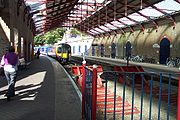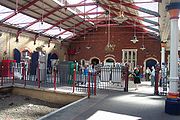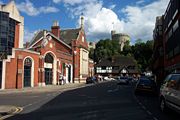
Windsor and Eton Riverside railway station
Encyclopedia



Windsor, Berkshire
Windsor is an affluent suburban town and unparished area in the Royal Borough of Windsor and Maidenhead in Berkshire, England. It is widely known as the site of Windsor Castle, one of the official residences of the British Royal Family....
in Berkshire
Berkshire
Berkshire is a historic county in the South of England. It is also often referred to as the Royal County of Berkshire because of the presence of the royal residence of Windsor Castle in the county; this usage, which dates to the 19th century at least, was recognised by the Queen in 1957, and...
, England. The station, close to the River Thames
River Thames
The River Thames flows through southern England. It is the longest river entirely in England and the second longest in the United Kingdom. While it is best known because its lower reaches flow through central London, the river flows alongside several other towns and cities, including Oxford,...
and Windsor Castle
Windsor Castle
Windsor Castle is a medieval castle and royal residence in Windsor in the English county of Berkshire, notable for its long association with the British royal family and its architecture. The original castle was built after the Norman invasion by William the Conqueror. Since the time of Henry I it...
, is a grade II listed building.
It is the terminus of the Staines to Windsor Line and is served by South West Trains
South West Trains
South West Trains is a British train operating company providing, under franchise, passenger rail services, mostly out of Waterloo station, to the southwest of London in the suburbs and in the counties of Surrey, Hampshire, Dorset, Devon, Somerset, Berkshire, and Wiltshire and on the Isle of Wight...
from Waterloo, some 41 km (25¾ miles) to the east. It should not be mistaken for the nearby Windsor & Eton Central station, served by First Great Western
First Great Western
First Great Western is the operating name of First Greater Western Ltd, a British train operating company owned by FirstGroup that serves Greater London, the South East, South West and West Midlands regions of England, and South Wales....
trains from Slough station
Slough railway station
Slough railway station, in Slough, Berkshire, England, is served by local services operated by First Great Western from to and intercity services on the Great Western Main Line, the original line of the Great Western Railway...
on the Great Western Main Line
Great Western Main Line
The Great Western Main Line is a main line railway in Great Britain that runs westwards from London Paddington station to the west of England and South Wales. The core Great Western Main Line runs from London Paddington to Temple Meads railway station in Bristol. A major branch of the Great...
.
Description
The station building was designed by William TiteWilliam Tite
Sir William Tite, CB was an English architect who served as President of the Royal Institute of British Architects. He was particularly associated with various London buildings, with railway stations and cemetery projects....
as a royal station with a stone-faced frontage with a mullioned and transomed main window, gables and a multi-arch entrance. The main booking hall was decorative but is now a wine bar
Wine bar
A wine bar is a tavern-like business focusing on selling wine, rather than liquor or beer. A typical feature of many wine bars is a wide selection of wines available by the glass. Some wine bars are profiled on wines of a certain type of origin, such as Italian wine or Champagne...
. There is a spacious concourse under the train shed
Train shed
A train shed is an adjacent building to a railway station where the tracks and platforms are covered by a roof. It is also known as an overall roof...
at the head of the platforms. The two platforms extend a considerable distance beyond the train shed.
The wall on south east (Datchet Road) side of the station forms a long curve, parallel with the platform, containing a series of arches with depressed heads. This wall links the station proper with the former Royal Waiting Room built for Queen Victoria
Victoria of the United Kingdom
Victoria was the monarch of the United Kingdom of Great Britain and Ireland from 20 June 1837 until her death. From 1 May 1876, she used the additional title of Empress of India....
. This is a small building of main room and ante rooms crowned by a turret
Turret
In architecture, a turret is a small tower that projects vertically from the wall of a building such as a medieval castle. Turrets were used to provide a projecting defensive position allowing covering fire to the adjacent wall in the days of military fortification...
with spire
Spire
A spire is a tapering conical or pyramidal structure on the top of a building, particularly a church tower. Etymologically, the word is derived from the Old English word spir, meaning a sprout, shoot, or stalk of grass....
let, and has Tudor arch
Tudor arch
A four-centred arch, also known as a depressed arch or Tudor arch, is a low, wide type of arch with a pointed apex. It is much wider than its height and gives the visual effect of having been flattened under pressure...
ed windows. The interior of the main room has a ribbed ceiling with a pendant
Pendant
A pendant is a loose-hanging piece of jewellery, generally attached by a small loop to a necklace, when the ensemble may be known as a "pendant necklace". A pendant earring is an earring with a piece hanging down. In modern French "pendant" is the gerund form of “hanging”...
finial
Finial
The finial is an architectural device, typically carved in stone and employed decoratively to emphasize the apex of a gable or any of various distinctive ornaments at the top, end, or corner of a building or structure. Smaller finials can be used as a decorative ornament on the ends of curtain rods...
.
History
The route from StainesStaines railway station
Staines railway station is in Staines, Surrey. South West Trains manage it and provide all services which are down to , and and up to London Waterloo....
was authorised in 1847 and was opened by the Windsor, Staines and South Western Railway as far as Datchet
Datchet railway station
Datchet railway station is a railway station serving the village of Datchet in Berkshire, England. The station is located on the line between Windsor and Eton Riverside and London Waterloo, which lies to the east....
, on the opposite side of Home Park
Home Park, Windsor
The Home Park, previously known as the Little Park , is a private Royal park, administered by the Crown Estate. It lies on the eastern side of Windsor Castle in the town and civil parish of Windsor, Berkshire....
from the town of Windsor, on 22 August 1848. Opposition from both Windsor Castle and Eton College
Eton College
Eton College, often referred to simply as Eton, is a British independent school for boys aged 13 to 18. It was founded in 1440 by King Henry VI as "The King's College of Our Lady of Eton besides Wyndsor"....
delayed the completion of the line (there was similar opposition to the Great Western Railway
Great Western Railway
The Great Western Railway was a British railway company that linked London with the south-west and west of England and most of Wales. It was founded in 1833, received its enabling Act of Parliament in 1835 and ran its first trains in 1838...
line to Windsor Central), but eventually the Riverside station was opened on 1 December 1849.
In 1848 before Riverside station opened, the Windsor, Staines and South Western Railway had been incorporated into the London and South Western Railway
London and South Western Railway
The London and South Western Railway was a railway company in England from 1838 to 1922. Its network extended from London to Plymouth via Salisbury and Exeter, with branches to Ilfracombe and Padstow and via Southampton to Bournemouth and Weymouth. It also had many routes connecting towns in...
(LSWR), which ran the services until 1923 when, under the railway grouping of the Railways Act 1921
Railways Act 1921
The Railways Act 1921, also known as the Grouping Act, was an enactment by the British government of David Lloyd George intended to stem the losses being made by many of the country's 120 railway companies, move the railways away from internal competition, and to retain some of the benefits which...
, the LSWR became part of the Southern Railway
Southern Railway (Great Britain)
The Southern Railway was a British railway company established in the 1923 Grouping. It linked London with the Channel ports, South West England, South coast resorts and Kent...
. In 1930 the line was electrified
Railway electrification system
A railway electrification system supplies electrical energy to railway locomotives and multiple units as well as trams so that they can operate without having an on-board prime mover. There are several different electrification systems in use throughout the world...
on the third rail
Third rail
A third rail is a method of providing electric power to a railway train, through a semi-continuous rigid conductor placed alongside or between the rails of a railway track. It is used typically in a mass transit or rapid transit system, which has alignments in its own corridors, fully or almost...
system at a nominal 660 volt
Volt
The volt is the SI derived unit for electric potential, electric potential difference, and electromotive force. The volt is named in honor of the Italian physicist Alessandro Volta , who invented the voltaic pile, possibly the first chemical battery.- Definition :A single volt is defined as the...
s DC
Direct current
Direct current is the unidirectional flow of electric charge. Direct current is produced by such sources as batteries, thermocouples, solar cells, and commutator-type electric machines of the dynamo type. Direct current may flow in a conductor such as a wire, but can also flow through...
. In the 1948 Nationalization
Nationalization
Nationalisation, also spelled nationalization, is the process of taking an industry or assets into government ownership by a national government or state. Nationalization usually refers to private assets, but may also mean assets owned by lower levels of government, such as municipalities, being...
the line became part of the Southern Region of British Railways
Southern Region of British Railways
The Southern Region was a region of British Railways from 1948. The region ceased to be an operating unit in its own right in the 1980s and was wound up at the end of 1992. The region covered south London, southern England and the south coast, including the busy commuter belt areas of Kent, Sussex...
.
In 1974 the level crossing
Level crossing
A level crossing occurs where a railway line is intersected by a road or path onone level, without recourse to a bridge or tunnel. It is a type of at-grade intersection. The term also applies when a light rail line with separate right-of-way or reserved track crosses a road in the same fashion...
in the throat of the station giving access to Romney Lock
Romney Lock
Romney Lock is a lock on the River Thames in England near Windsor and Eton. It is on the Windsor side of the river next to a boatyard and adjoins Romney Island, a long strip of land in the middle of the river. The first lock was built by the Thames Navigation Commission in 1798.The weir is some...
was closed and replaced by a footbridge. Vehicular access to the lock was maintained by a road constructed on the north side of the station through the former goods yard which became the station car park.
As part of the privatisation of British Rail
Privatisation of British Rail
The privatisation of British Rail was set in motion when the Conservative government enacted, on 19 January 1993, the British Coal and British Rail Act 1993 . This enabled the relevant Secretary of State to issue directions to the relevant Board...
, the Stagecoach Group
Stagecoach Group
Stagecoach Group plc is an international transport group operating buses, trains, trams, express coaches and ferries. The group was founded in 1980 by the current chairman, Sir Brian Souter, his sister, Ann Gloag, and her former husband Robin...
company South West Trains
South West Trains
South West Trains is a British train operating company providing, under franchise, passenger rail services, mostly out of Waterloo station, to the southwest of London in the suburbs and in the counties of Surrey, Hampshire, Dorset, Devon, Somerset, Berkshire, and Wiltshire and on the Isle of Wight...
took over operation of the service and the station in 1996. Ownership of the line and station passed to Railtrack
Railtrack
Railtrack was a group of companies that owned the track, signalling, tunnels, bridges, level crossings and all but a handful of the stations of the British railway system from its formation in April 1994 until 2002...
and subsequently to Network Rail
Network Rail
Network Rail is the government-created owner and operator of most of the rail infrastructure in Great Britain .; it is not responsible for railway infrastructure in Northern Ireland...
.
Incidents
On 22 May 2009, the end carriage of the 06:15 departure derailed as the train pulled out of the station causing disruption to services for much of the day. No services ran the full route, with an hourly service terminating at Datchet and all other trains terminating at Staines.On 11 October 2009, the bogie of a DEMU (vehicle 60118), on the 'The Eton Rifles' tour, derailed on arrival at platform 1.
The whole tour was unable to continue and passengers were sent out on the next service train.
The Rail Accident Investigation Branch
Rail Accident Investigation Branch
The Rail Accident Investigation Branch is a government agency that became operational on 17 October 2005. Its primary role is the investigation of rail accidents in the United Kingdom and the Channel Tunnel in order to find a cause, not to lay blame. The agency has operational centres in The...
was investigating the derailment.
Services
There is usually a half-hourly service to London Waterloo seven days a week, taking just over an hour to reach Waterloo. The service is currently provided by South West TrainsSouth West Trains
South West Trains is a British train operating company providing, under franchise, passenger rail services, mostly out of Waterloo station, to the southwest of London in the suburbs and in the counties of Surrey, Hampshire, Dorset, Devon, Somerset, Berkshire, and Wiltshire and on the Isle of Wight...
using Class 450/5
British Rail Class 450
The British Rail Class 450 third-rail DC EMU began service during 2003. They are a part of the Siemens Desiro modular train family and are more commonly known as the 'Blue Desiro'...
Desiro
Desiro
The Siemens Desiro is a family of diesel or electric multiple unit passenger trains. The main variants are the Desiro Classic, Desiro ML, Desiro UK and the future Desiro City and Desiro RUS. The trains are mostly used for commuter and regional services, and their rapid acceleration makes them...
units, Class 455
British Rail Class 455
The British Rail Class 455 is a type of electric multiple unit drawing power from a 750 V DC third rail. Built by BREL at York works in the early and mid-1980s, they were initially categorised as Class 510 as the successor to the Class 508...
units, and Class 444
British Rail Class 444
The British Rail Class 444 Desiro electrical multiple units were built in Germany by Siemens AG from 2003-04. Forty-five of these units were built for express services for South West Trains....
units.

